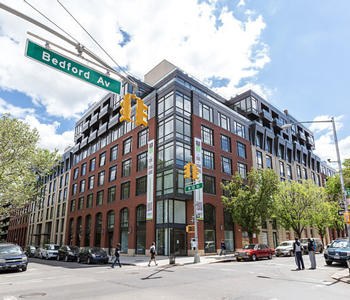Prolific architect Karl Fischer, known for his ubiquitous though sometimes critically panned designs in Brooklyn, died last week. He was 70.
Fischer opened his first architecture firm in 1984 in Montreal, eventually expanding to New York City in 1999. The firm most recently rebranded into two businesses, Fischer + Makooi Architects in New York and Fischer Rasmussen Whitefield Architects in Montreal.

101 Bedford Avenue in Brooklyn
In New York, his best known work includes a 33-story condo tower at 172 Madison Avenue, a 350-unit rental project at 101 Bedford Avenue, the condominium conversion of the Gretsch Factory, Schaefer Landing on the Williamsburg waterfront and multifamily buildings on Bayard Street known as “Karl Fischer Row.” Over the years, he’s borne the brunt of criticism that his work sacrificed aesthetics for speed and cost. In 2011, the New York Post referred to him as “New York’s most loathed architect.” Still, developers repeatedly hired him, making him among the city’s busiest architects. In The Real Deal’s most recent ranking of the city’s architects, based on volume of projects completed in 2018, he placed 15th.
“You look at negative criticism, and you try to learn from it and move on,” he told TRD in 2016. “When I get the criticism, I look at the building, and I think, ‘Did I do the best I could do?’ and sometimes the answer is no, but most of the time the answer is yes.”
David Maundrell, of Citi Habitats, who marketed close to 1,000 apartments designed by Fischer, said the architect didn’t seem fazed by the criticism. He noted that much of the opposition likely stemmed from aversion to development in general, since Fischer’s designs played a role in transforming Williamsburg.
He said Fischer built a “loyal fanbase” of developers, who were drawn to his work ethic and efficiency. The architect also placed emphasis on a building’s interiors, Maundrell said.
“Karl had a general understanding of how to create livable apartments. Not every architect does,” he said. “Karl worked from the inside out. Interiors weren’t compromised by a pretty facade.”
Architect Gene Kaufman, who worked with Fischer on a few projects and even lent him a desk in his office when he was first learning the ropes of working in New York, called him a “developer’s architect.” He said Fischer largely built up a client base through word-of-mouth, as clients — many within the Orthodox Jewish development community — endorsed his work. Kaufman echoed that Fischer had a talent for laying out space in residential developments.
“He ended up getting a great deal of work, and I don’t think that was just by chance,” Kaufman said.
Fariba Makooi, who took over Fischer’s New York office in 2017, said Fischer worked expertly within the many restrictions innate in designing in the city.
“Karl was very conscious about what is in the best interest of the end user,” she said. “He worked tirelessly [to ensure] that the layouts were something that people wanted to live in. And that is really his legacy.”
According to an obituary posted on Goss Funeral Services’ website, he died on March 12 in Vermont. He is survived by his wife, Pamela, and their two children, as well as three grandchildren. A private memorial will be held in Montreal sometime in the spring.
“Whether he was driving the tractor, designing a luxury treehouse for his granddaughters, or bushwhacking through the deep snow on his cross-country skis, Karl was never happier than when he had a long list of tasks to accomplish,” the obituary states. “If he wasn’t fixing something or chopping something down, he could be found cycling through the Green Mountains, snowboarding at Jay Peak, flying his plane, or climbing Mount Kilimanjaro.”
